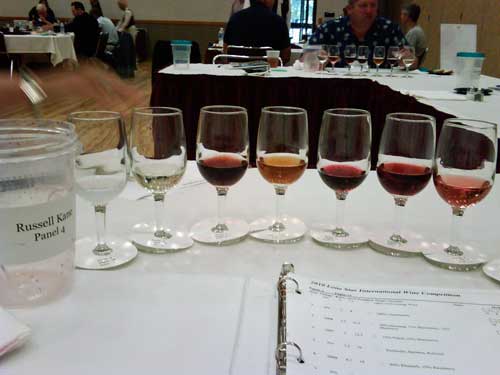
2010 Lone Star International Wine Competition Brings New Experiences for Texas Wines, Wineries and Judges
I have been a judge in the Lone Star wine competitions in Grapevine, Texas, (https://www.grapevinetexasusa.com) many years ago, but just got the nod again last year and again this year; but what a difference a year makes. This year’s 2010 Lone Star International Wine Competition was a different sort of experience. More wines from established and emerging wine producing regions and an greater emphasis on varietals outside the standard mix: Cabernet, Merlot, Pinot Noir and Chardonnay.
For those of you that have not been privy to the intersanctum of wine judging you might think that the judges know in advance the names of the wines they taste or might even sink so low as to already have been coached as who should get the medals. Well, I can’t speak for ALL wine competitions around the world, but the Lone Star International Wine Competition walks the straight a narrow. All of the wines are kept in a separate room and blinded. All we saw for the past two days were seemingly never ending flights of wines in unmarked glasses. Some of the wines were straw yellow, some purple-red and others a variety of colors from hot pink to sunset orange to thick dirt brown; one was even a cloudy white. Texas, sake perhaps? Nope, it was something else.
The judging was done using the festival method. The judging panel members first evaluate the wines in a particular flight and assess them for color, body, aroma, balance, flaws and other geeky wine parameters. Then, they independently come up with a rating of one of the following:
- No Medal
- Bronze Medal
- Silver Medal
- Gold Medal
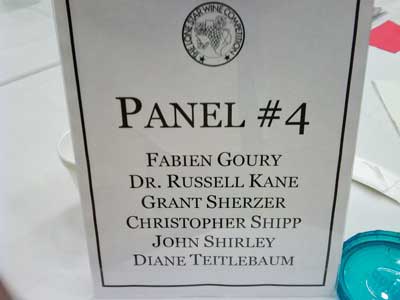
When the panel members are finished with their individual ratings, they are presented in an open manner to a panel leader and other panel judges. Sometimes, the panelists have similar rankings, but other times they vary. We had two flights where two judges voted no medal and two judges voted either silver or gold medal for the same wine. What did we do at that point? Well, judges then explained the basis for their vote. Sometimes they questioned if certain wine flaws were present or what was the intended winemaking style. This usually prompted a re-taste and a second round of voting, usually with closer results. While being a semi-quantitative method of ranking, I have found it a good one as it usually leads to a compromise and a generally accurate assessment of wines. However, I have also used the numerical method, that specified under the U.C. Davis 20-point ranking with good success, as well.
After the first day of the competition, some of the judges got together at a BYOB restaurant that had great Italian food. What better combination, a table full of wine judges (two Master Sommeliers to boot; can you name one MS in the photo below), a table full of wines brought to the dinner by some of the judges, some with vintages back to 1993, and Italian food.
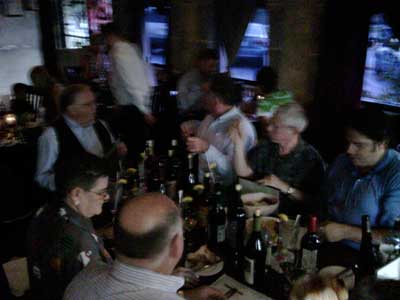
On Day 2, one flight of red wines consisted of about eighteen wines. This is rather large and perhaps next year the competition organizers will find a way to reduce the opportunity of this situation utilizing some sub-classifications either by price, varietal, body or style. Nevertheless, we work through the rather large flight by breaking it up into smaller-sized bites that culled out the keepers, which were then evaluated against each other.
The most interesting aspect of this year’s competition was the prevalence of new varietals beyond Cabernet, Merlot, Chardonnay and Pinot, particularly in the Gold and Silver Medal winners circle. This was particularly good to see for Texas, as it is a warm winegrowing region and, face it, Texas just ain’t Bordeaux or Burgundy for that matter, and won’t be unless we go through a major new epoch of global cooling and glaciation. We had a longer than usual list of winning wines made from varietals that were originally at home in Spain, the Rhone Valley and Italy know for their dry, hot and sunny summer weather much like we have in Texas. We also had a major contingency of wines from California, its Central Coast region including Paso Robles, New York, Arizon, Oregon to name just a few regions.
Texas Grand Star Award Winners
Three Grand Star Awards (the equivalent to a Double Gold Medal – i.e. best of the best) were given to Texas wineries that were determined from a second round of judging consisting of only wines with the highest scores from the first day of the competition. These Grand Star Texas wines included:
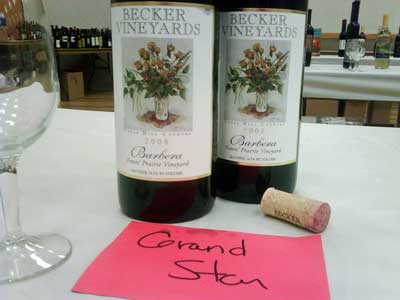
Becker Vineyards Barbera (Peter’s Prairie Vineyard)
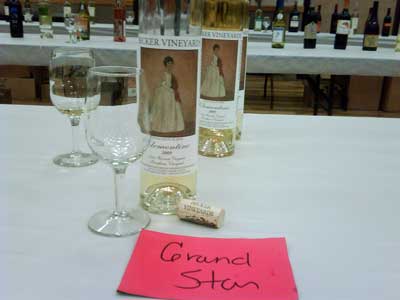
Becker Vineyards Clementine (Late Harvest Viognier)
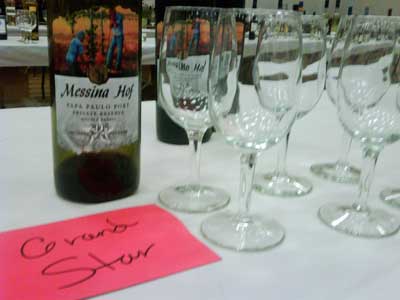
Messina Hof Papa Paulo Port (made from the Black Spanish grape – also called Lenoir)
— — — —
Gold and Silver Medal Winning Texas Wines
After the judging was completed, we received a list of the Gold and Silver Medal wines and were able to inspect the bottles and taste. Wines from Texas wineries with Gold or Silver Medals are listed below.
Becker Vineyards: Gold – Barbera Peter’s Prairie, Clementine; Silver – Zinfandel Peter’s Prairie, Reserve Merlot, Cabernet Sauvignon Reserve – Newsom, Roussanne, Chardonnay Reserve Hidden House
Bending Branch Estate Vineyard: Gold – Petite Sirah; Silver – Picpoul Blanc, Tannat
Brennan Vineyards: Silver – Austin Street Red
Bruno & George Wines: Gold – Cardinal Cranberry
Calais Winery: Silver – Cuvee des Marrons
Certenberg Vineyard: Silver – Gotas de Oro
Cocktail Wine: Silver – Sabor Azul Limon (This was the cloudy white wine drink I mentioned previously and shown in the picture at the top of the page.)
CrossRoads Winery: Silver – Merlot, CSM
Driftwood Estate Winery: Gold – Orange Muscat, Portejas; Silver – Sangiovese, Viognier, Syrah
D’Vine Wine (Grapevine): Gold – Sunset (Peach)
Enoch’s Stomp Vineyard: Gold – Ellen’s Sweet Song; Silver – Potter Hand, Bland Du Bois – Off Dry
Fairhaven Vineyards: Gold – Chambourcin
Fall Creek Vineyards: Silver – Tempranillo
Georgetown Winery: Gold – Lone Star Frost (after last year’s spring weather in Texas, I wonder if this name was selected tongue in cheek); Silver – Sauvignon Blanc
Grape Creek Vineyards: Gold – Bellissimo Super Tuscan, Mosaic, Viognier Lost Draw; Silver – Cabernet Sauvignon Syrah, Pinot Grigio
Haak Vineyards: Silver – Blanc Du Bois Semi-Sweet, Blanc Du Bois Madeira
Homestead Winery: Silver – Merlot
Khatter Vineyards: Silver – Texas Sweet Ruby Carbernet
Kiepersol Estate Vineyards: Gold – 4 You Merlot; Silver – Cabernet Sauvignon, Texas Merlot, 4 Your Syrah
Llano Estacado Winery: Gold – Viviano, Raider Tempranillo; Silver – Viviana, Raider Viognier, Moscato, Signature Melange, Cellar Reserve Merlot Newsom, Cellar Reserve Cabernet Sauvignon, Tempranillo High Plains Newsom
Lone Oak Winery: Silver – Tempranillo Lost Draw
Los Pinos Ranch Vineyard: Silver – Sangiovese Bin 9
Mandola Estate Winery: Silver – Orange Muscat, Vermentino, Moscato, Bainco (all Duchman Family Winery)
McPherson Cellars: Gold – Rose of Syrah; Silver – Sangiovese
Messina Hof Winery: Gold – Papa Paulo Port Private Reserve; Silver – Muscat Canelli, Riesling Merrill’s Vineyard, Cabernet Franc Private Reserve
Pedernales Cellars: Silver – Tempranillo
Peregrine Hill Winery: Gold – Brix Sweet Shiraz; Silver – Cabernet Sauvignon, Brix Sweet Pinot Grigio (Don’t forget that there are lots of sweet wine drinkers in Texas! It part of our heritage.)
Pillar Bluff Vineyards: Silver – Viognier
Pleasant Hill Winery: Silver – Collina Bianca
Red Caboose Vineyard: Silver – Viognier, Tempranillo Lenoir, Cabernet Sauvignon
Red Road Vineyard: Silver – Las
San Martino Winery: Silver – Reserved Syrah, Texano, Tempranillo, Merlot
Seifert Cellars: Silver – Fiesta
Stone House Vineyard: Silver – Scheming Beagle Port, The Lyre Tempranillo, Claros 2008
Sunset Winery: Silver – 2004 Proprietor’s Reserve Barrel Blend Texas High Plains (Also medal for the longest wine name ).
Triple “R” Ranch & Winery: Silver – “Big Red” Reserve Meritage
Water 2 Wine: Silver – Rattlesnake Cabernet Shiraz, Washington Cabernet Sauvignon, Italian Barbera
Zin Valley Vineyards: Silver – Rising Star Pinot Noir Reserve, Rising Star Sparking Wine
Website information for Texas wineries can be found at: http://www.gotexanwine.org/findwinesandwineries/ or search using the winery name on Google (http://www.google.com)
The Bronze Medal winners were not highlighted and will be included in the formal announcement of the winners from the Texas Wine and Grape Growers Association (http://www.txwine.org).
Another interest aspect of the wine competition was that the judges proved that they could pick the good wines regardless of their origin. The Cakebread Cellars Carneros Napa Valley Syrah was judged in the Lone Star competition and received a Gold Medal. Robert Hall Winery near Paso Robles, California, received three Gold Medals for their Rhone de Robles, Merlot and Cabernet Sauvignon. Arizona Stronghold received a Gold Medal for their Nachise, Biltmore Estates in North Carolina garnered a Gold for the NC Riesling, and Dr. Konstantin Frank from the Finger Lakes region of New York brought home a Gold for their Riesling Semi-Dry. Bodegas Paso Robles was a show-stopper. They were a winery that most of the judges did not immediately recognize when they got to see the winner’s list. but they that won two Gold Medals for their Graciano (Italian red varietal) and their Viva You red blend.
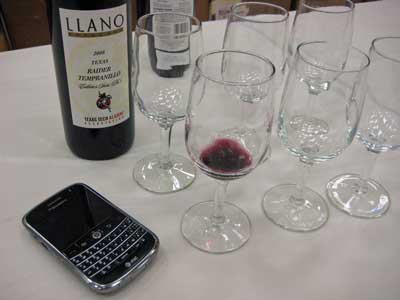
Several of judges twitter about our experiences and about the Gold and Silver Medal winning wines. To see some of these comments go to the following Twitter accounts:
Russ Kane (VintageTexas): https://twitter.com/VintageTexas
Renie Steves: https://twitter.com/reniesteves
Jeff Siegel (Wine Curmudgeon): https://twitter.com/wine_curmudgeon
JonBonnell: https://twitter.com/jonbonnell
Honorable mentions to the following for retweeting some of our numerous Tweets during the after the competition:
Ben at Vinotology: https://twitter.com/vinotology
Ken at Alawine: https://twitter.com/alawine
Thanks also to wine competition chairs, Michael Zerbacha nd Barbara Worley MS, and Jodie Post and Monica from the Texas Wine and Grape Grower Association (TWGGA) for all their hard work and dedication that made this a first-class, international wine competition.
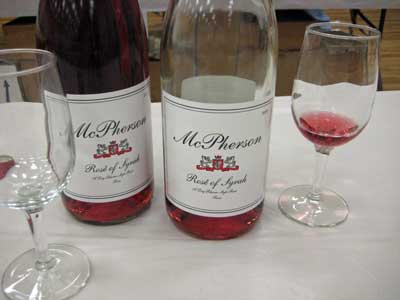

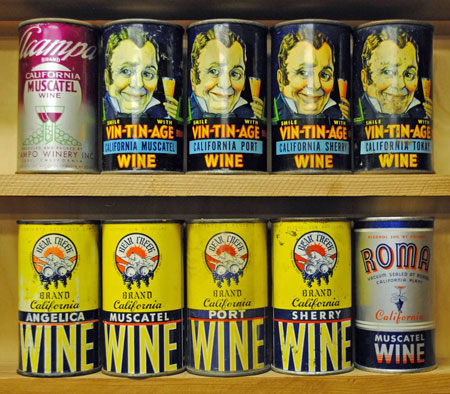
Be the first to comment